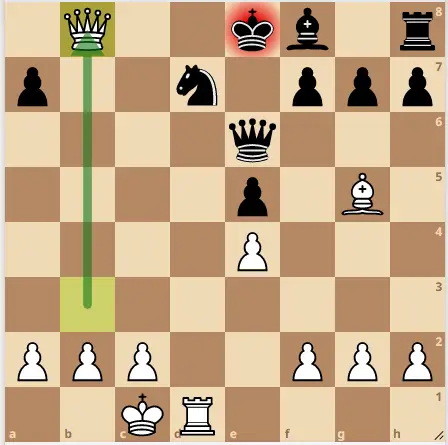While many chess players strive to make good moves, some moves stand out as brilliant, creative, and unexpected. A brilliant move can turn the tide of a game, confound opponents, and leave a lasting impression on chess enthusiasts.
But what exactly makes a move brilliant, and how can players learn to identify and play such moves? In this article, we’ll explore what constitutes a brilliant move in chess, examine some famous examples of brilliant moves from the history of the game, and provide tips and strategies for developing the mindset and skills necessary to play brilliant chess.
Whether you’re a beginner or an experienced player, understanding the concept of brilliant moves can help you improve your game and appreciate the beauty and complexity of this timeless game of strategy.
What Is A Brilliant Move In Chess?
In chess, a brilliant move is a move that is unexpected, ingenious, and has a significant impact on the game. It is a move that is beyond the typical or expected moves and requires deep thinking and strategic planning.
Some examples of brilliant moves in chess include sacrificing a piece to gain a strategic advantage, creating a powerful and unexpected attack, or setting up a clever trap for the opponent.
One famous example of a brilliant move is the “Immortal Game,” played between Adolf Anderssen and Lionel Kieseritzky in 1851. In this game, Anderssen sacrificed his bishop and two rooks to set up a stunning and decisive attack on Kieseritzky’s king, which is considered one of the most beautiful games in chess history.
Overall, a brilliant move in chess is not only about finding the best move on the board, but also about creating a game-changing moment that requires deep understanding of the game and the ability to think outside the box.
The Immortal Game
Brilliant move: White sacrifces his queen on f6 and forces checkmate after 22…Nxf6 23.Be7#
This was chess in the romantic era. White sacrificed a queen, two rooks and a bishop to mate Black with only three pieces – a masterpiece by Anderssen and one of the most famous chess games of all time.
How To Play Brilliant Moves?
Playing brilliant moves in chess requires a combination of several skills, including strategic thinking, tactical vision, creativity, and experience. Here are some tips that can help you play brilliant moves in chess:
Understand the position
Before making a move, take some time to evaluate the position and understand the strengths and weaknesses of both your and your opponent’s position.
Look for tactical opportunities
Sometimes, the best moves are not the most obvious ones. Look for tactical opportunities, such as forks, pins, and skewers, that can create problems for your opponent.
Play creatively
Don’t always stick to the same opening or strategy. Be willing to try new and creative ideas to surprise your opponent and keep them off balance.
Calculate variations
When considering a move, calculate variations and anticipate your opponent’s possible responses. This will help you identify the best move that maximizes your advantage and minimizes your opponent’s counterplay.
Study master games
Studying the games of great chess players can give you inspiration and ideas for how to play brilliant moves. Try to understand their thought process and the reasoning behind their moves.
Practice regularly
The more you practice, the more you will develop your skills and intuition for finding brilliant moves. Play regularly against opponents of varying strengths to challenge yourself and improve your game.
Remember, playing brilliant moves in chess is not just about winning but also about enjoying the game and expressing your creativity. So, have fun and keep learning!
Examples Of Brilliant Moves Throughout Chess History
There have been countless brilliant moves played throughout the history of chess, but here are some notable examples:
“The Immortal Game” (Anderssen vs. Kieseritzky, 1851)
In this famous game, Anderssen sacrificed his bishop and 2 rooks to create a devastating attack that led to a stunning checkmate that finished off with a queen sacrifice.
Brilliant Move: 22.Qf6

“The Opera Game” (Morphy vs. Duke Karl / Count Isouard, 1858)
This match was played at Opera house in Paris. In this game, Morphy played against 2 strong amateur players, Duke Karl and Count Isouard who teamed up together with the black pieces. Morphy sacrificed multiple pieces including his knight, an exchange and ultimately his queen to set up a beautiful mating combination.
Brilliant move: Qb8+

“The Game of the Century” (Fischer vs. Byrne, 1956)
In this game, the 13-year-old Bobby Fischer played a stunning sacrifice of his queen to create a winning attack. In exchange for the queen sacrifice, Fischer got a rook, two bishops, and a pawn. The pieces coordinated harmoniously to force a devastating checkmate.
Fischer ignores the threat on his queen and plays the brilliant move 17…Be6

“Deep Blue vs. Kasparov” (1997)
In the final game of their rematch (Game 6), Deep Blue played a stunning positional sacrifice as early as move 8, that hindered Kasparov’s development of his piece. Deep blue as White was able to outplay Kasparov due to the positional advantage from the sacrifice.
Kasparov was shooked by the brilliant move 8.Nxe6
These are just a few examples of the many brilliant moves played in the history of chess.
Common Mistakes To Avoid When Seeking Brilliant Moves
Here are some common mistakes to avoid when seeking brilliant moves in chess:
- Overlooking your opponent’s potential responses: When seeking a brilliant move, it’s important to consider how your opponent might respond and whether your move will actually benefit your position in the long run.
- Neglecting basic principles: Brilliant moves are often built on a solid foundation of basic principles like control of the center, development of pieces, and pawn structure. Neglecting these principles in favor of flashy, but unsound moves can often lead to disaster.
- Being too aggressive: While aggressive play is often necessary to find brilliant moves, being too aggressive can leave your pieces exposed and vulnerable to attack.
- Ignoring your opponent’s threats: A brilliant move may be tempting, but ignoring your opponent’s threats can result in unexpected losses.
- Failing to calculate accurately: Brilliant moves often involve complex calculations and require accurate assessment of the position. Failing to calculate accurately can lead to missed opportunities and lost games.
- Focusing too much on one idea: Seeking a brilliant move can sometimes lead to tunnel vision, where you become fixated on one particular idea or tactic, ignoring other potential options that might be stronger.
By avoiding these common mistakes and staying focused on the fundamentals of the game, you can increase your chances of finding and playing brilliant moves in chess.
Final Thoughts
In summary, a brilliant move in chess is one that is creative, unexpected, and strategically sound. It is a move that can alter the course of a game and leave a lasting impression on both the players and the audience.
To find and play brilliant moves, chess players must develop a deep understanding of the game’s principles, analyze positions carefully, and cultivate a creative mindset.
By avoiding common mistakes and staying focused on the fundamentals, players can increase their chances of finding and playing brilliant moves in their games.
Ultimately, the pursuit of brilliant moves is not just about winning games, but about appreciating the artistry and beauty of this ancient game of strategy. Whether you’re a casual player or a seasoned pro, the quest for brilliant chess moves is an endlessly fascinating and rewarding endeavor.


